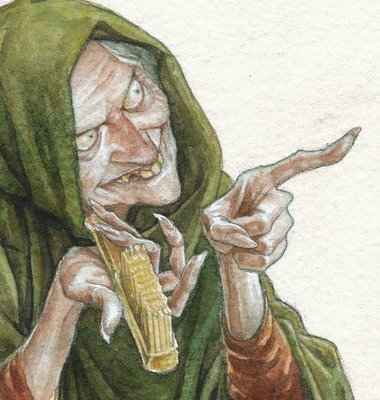A
hag is a wizened old woman, or a kind of fairy or goddess having the
appearance of such a woman, often found in folklore and children’s tales
such as Hansel and Gretel. Hags are often seen as malevolent, but may also
be one of the chosen forms of shape-shifting deities, such as the Morrígan
or Badb, who are seen as neither wholly beneficent nor malevolent. The term
appears in Middle English, and was a shortening of hægtesse, an Old English
term for witch, similarly the Dutch heks and German hexe are also
shortenings, of the Middle Dutch haghetisse and Old High German hagzusa
respectively. All these words derive from the Proto-Germanic hagatusjon,
which is of unknown origin, however the first element may be related to the
word “hedge”. As a stock character in fairy or folk tale, the hag shares
characteristics with the crone, and the two words are sometimes used as if
interchangeable.
A
hag, or “the Old Hag”, was a nightmare spirit in English and Anglophone
North American folklore. This variety of hag

is
essentially identical to the Old English mæra — a being with roots in
ancient Germanic superstition, and closely related to the Scandinavian mara.
According to folklore, the Old Hag sat on a sleeper’s chest and sent
nightmares to him or her. When the subject awoke, he or she would be unable
to breathe or even move for a short period of time. In the Swedish film
Marianne, the main character suffers from these nightmares. This state is
now called sleep paralysis, but in the old belief the subject had been
“hagridden”. It is still frequently discussed as if it were a paranormal
state.
Many
stories about hags seem to have been used to frighten children into being
good. The Northern English Peg Powler, for example, was a river hag who
lived in the River Tees and had skin the color of green pond scum. Parents
who wanted to keep their children away from the river’s edge told them
that if they got too close to the water she would pull them in with her long
arms, drown them, and sometimes eat them. This type of nixie or neck has
other regional names, such as Grindylow (a name connected to Grendel), Jenny
Greenteeth from Yorkshire, and Nellie Longarms from several English
counties.
Many
tales about hags do not describe them well enough to distinguish between an
old woman who knows magic or a supernatural being.
In
Slavic folklore, Baba Yaga was a hag who lived in the woods in a house on
chickens’ legs. She would often ride through the forest on a mortar,
sweeping away her tracks with a broom. Though she is usually a single being,
in some folktales three Baba Yagas are depicted as helping the hero in his
quest, either by giving advice or by giving gifts.
In
Irish and Scottish mythology, the cailleach is a hag goddess concerned with
creation, harvest, the weather and sovereignty. In partnership with the
goddess Bríd, she is a seasonal goddess, seen as ruling the winter months
while Bríd rules the summer. In Scotland, a group of hags, known as The
Cailleachan (The Storm Hags) are seen as personifications of the elemental
powers of nature, especially in a destructive aspect. They are said to be
particularly active in raising the windstorms of spring, during the period
known as A Chailleach.
Hags
as sovereignty figures abound in Irish mythology. The most common pattern is
that the hag represents the barren land, which the hero of the tale must
approach without fear, and come to love on her own terms. When the hero
displays this courage, love, and acceptance of her hideous side, the
sovereignty hag then reveals that she is also a young and beautiful goddess.
The
Three Fates (particularly Atropos) are often depicted as hags.
In
Persian folklore, the Bakhtak has the same role as that of “the Old Hag”
in English folklore. The Bakhtak sits on a sleeper’s chest, awakening them
and causing them to feel they are unable to breathe or even to move. Bakhtak
also is used metaphorically to refer to “nightmare” in the modern
Persian language.